113 Painting Rack 1
Search This Category
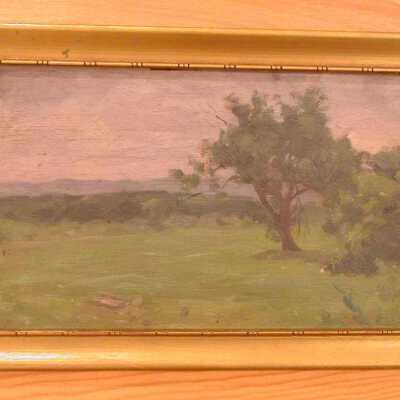

A Scene Near Woodstock
Name/Title
A Scene Near Woodstock
Type of Painting
Lexicon
Description
Oil painting on board showing a green field. There are trees on the right, and hills and mountains in the background. There is a sketch of a woman on the back of the board.
Acquisition
Accession
1957.1
Artwork Details
Medium
Oil
Made/Created
Artist Information
Marble, John Nelson (1855-1918)
Artist
Date made
1916-1918
Dimensions
Entry/Object ID
1957.1.345
Context
JOHN NELSON MARBLE (1855-1918), sketch artist and painter, was a Woodstock native, one of 12 children of Liberty Bates Marble and Elizabeth Woodward Marble. He spent his youth in and about Woodstock, and even at a young age showed a great aptitude for painting. At age 18, he was enrolled at the Normal Art School in Boston, and from there was one of the first students to attend the Art Students’ League in New York, in 1875, where he also kept a studio for a number of years. He later studied at the Academie Julian in Paris and spent the summer of 1900 in Florence, Italy, where he visited the studio of famous Woodstock sculptor Hiram Powers.
He spent most of his adult life in Santa Barbara, California, for his health, and enjoyed exploring the surrounding foothills on horseback, delighting in the splendid opportunities for outdoor life. It was while living in California that he became known as a colorist and produced most of his landscapes. But he is best known for his prolific facial renderings which reveal a remarkable and engaging study of character.
Mr. Marble returned to the East Coast in 1916 to complete a commission to paint perhaps his most famous work, a life-size portrait of Mrs. Mary Baker Eddy, founder of Christian Science, which today hangs in the historic Statehouse in Concord, New Hampshire. In Woodstock, he painted portraits of many prominent locals: Frederick Billings, Frederick Billings, Jr., Mrs. Frederick Billings, Rev. Moses Kidder, and A. B. Wilder, among many others. He cordially welcomed visitors to his studio here, where there was much interest in both his charm and his canvases, and he was known for his “gentle, dignified presence.” He died in 1918 as a result of pneumonia, at the Marble family homestead in Woodstock (the current site of Cabot Funeral Home), having never married.
-- From Woodstock History Center
He spent most of his adult life in Santa Barbara, California, for his health, and enjoyed exploring the surrounding foothills on horseback, delighting in the splendid opportunities for outdoor life. It was while living in California that he became known as a colorist and produced most of his landscapes. But he is best known for his prolific facial renderings which reveal a remarkable and engaging study of character.
Mr. Marble returned to the East Coast in 1916 to complete a commission to paint perhaps his most famous work, a life-size portrait of Mrs. Mary Baker Eddy, founder of Christian Science, which today hangs in the historic Statehouse in Concord, New Hampshire. In Woodstock, he painted portraits of many prominent locals: Frederick Billings, Frederick Billings, Jr., Mrs. Frederick Billings, Rev. Moses Kidder, and A. B. Wilder, among many others. He cordially welcomed visitors to his studio here, where there was much interest in both his charm and his canvases, and he was known for his “gentle, dignified presence.” He died in 1918 as a result of pneumonia, at the Marble family homestead in Woodstock (the current site of Cabot Funeral Home), having never married.
-- From Woodstock History Center
Web Links and URLs
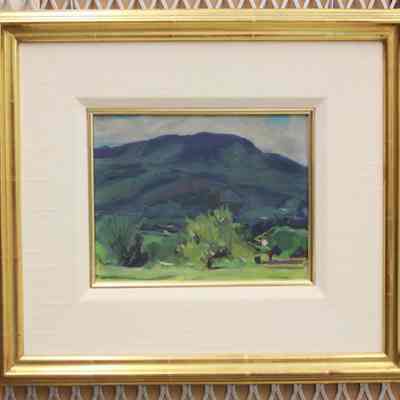
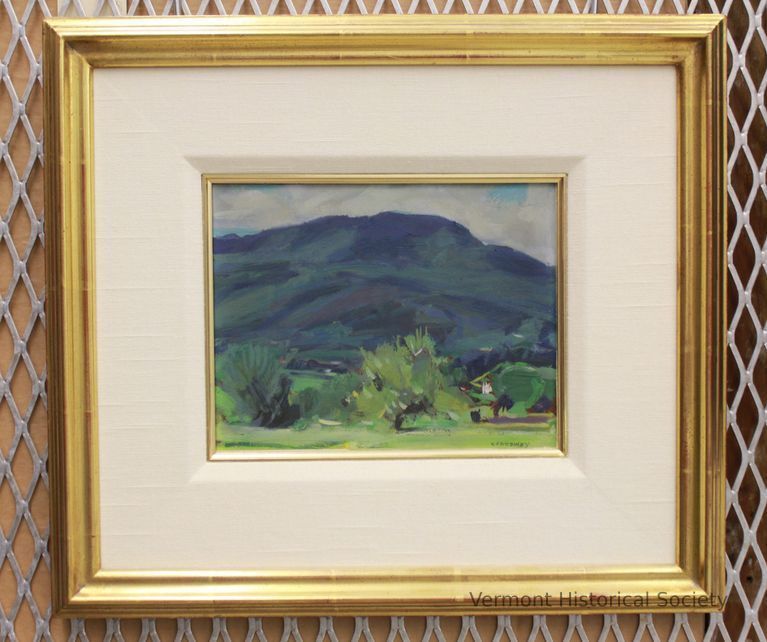
Dorset Mountains
Name/Title
Dorset Mountains
Lexicon
Description
Vibrant green and blue landscape dominated by a large mountain in the background with a small strip of clouded sky. The foreground depicts a lush, green valley with hints of structures and light green tree in the center. Modern label on the back indicates the title as, "Dorset Mountains."
Acquisition
Accession
2017.12
Artwork Details
Medium
Oil
Made/Created
Artist Information
Connaway, Jay Hall (1893-1970)
Artist
Date made
1965-1969
Entry/Object ID
2017.12.3
Context
Jay Connaway was born in Liberty, Indiana, November 27, 1893, the son of Cass Connaway, a lawyer and collector of Chinese art, and his wife May. Jay Connaway graduated from Emmerich Manual High School and undertook his first art training from William Forsyth, known for coastal Oregon views, at John Herron School of Art in Indianapolis in 1910 and 1911. Connaway left home to tour the California and Oregon coasts, working his way across the country and then back to the East Coast as a stoker on engines for the Atchison, Topeka, and Santa Fe Railroad.
In New York, Connaway enrolled at the National Academy of Design school in 1912. From 1912 to 1914 he attended the Art Student's League at New York City, where he studied with George Bridgman and with William Merritt Chase. Another influence was Robert Henri, a New York Social Realist and leader of the Ashcan School, whom Connaway had met while attending night classes at the National Academy.
In 1917 he enlisted and shipped out to Contrexeville, France. After suffering a shoulder wound, he worked as a cartographer. Then he was assigned to what he called "the most wonderful work of my life"—making detailed watercolor drawings of lesions caused by mustard gas. This brought him to the attention of Lafayette Page, a physician who was so impressed with Connaway's draftsmanship that, at the close of the war, he sponsored his studies at the Académie Julian (1919–20) under Jean Paul Laurens and at the École des Beaux-Arts (1921) in Paris.
With backing from collectors and gallery owners, Connaway, "seeking to paint the lonely sea" found his way to uninhabited Head Harbor Island off the coast of Jonesport, Maine where he lived as an artistic hermit. He later worked dories with a Grand Banks fishing fleet, was also a cook for a lumber camp in Maine, and he enlisted in the Coast Guard.
In 1928 Connaway married Louise Boehle. During the depression, Connaway moved to Monhegan Island to paint and start the Connaway Art School.
The Connaways remained on Monhegan until 1947, when they moved to Vermont, residing in Dorset until 1953, then North Rupert. Connaway painted rural landscapes of the Vermont countryside and operated a summer art school, until 1966.
In 1962, Connaway merged his school with the Southern Vermont Arts Center and became the school's first director. During the 1960s, in addition to managing the art school Connaway painted in Portugal, Spain, California, and Arizona. In the last year of his life, troubled with poor eyesight and failing health, Connaway was no longer able to paint.
In New York, Connaway enrolled at the National Academy of Design school in 1912. From 1912 to 1914 he attended the Art Student's League at New York City, where he studied with George Bridgman and with William Merritt Chase. Another influence was Robert Henri, a New York Social Realist and leader of the Ashcan School, whom Connaway had met while attending night classes at the National Academy.
In 1917 he enlisted and shipped out to Contrexeville, France. After suffering a shoulder wound, he worked as a cartographer. Then he was assigned to what he called "the most wonderful work of my life"—making detailed watercolor drawings of lesions caused by mustard gas. This brought him to the attention of Lafayette Page, a physician who was so impressed with Connaway's draftsmanship that, at the close of the war, he sponsored his studies at the Académie Julian (1919–20) under Jean Paul Laurens and at the École des Beaux-Arts (1921) in Paris.
With backing from collectors and gallery owners, Connaway, "seeking to paint the lonely sea" found his way to uninhabited Head Harbor Island off the coast of Jonesport, Maine where he lived as an artistic hermit. He later worked dories with a Grand Banks fishing fleet, was also a cook for a lumber camp in Maine, and he enlisted in the Coast Guard.
In 1928 Connaway married Louise Boehle. During the depression, Connaway moved to Monhegan Island to paint and start the Connaway Art School.
The Connaways remained on Monhegan until 1947, when they moved to Vermont, residing in Dorset until 1953, then North Rupert. Connaway painted rural landscapes of the Vermont countryside and operated a summer art school, until 1966.
In 1962, Connaway merged his school with the Southern Vermont Arts Center and became the school's first director. During the 1960s, in addition to managing the art school Connaway painted in Portugal, Spain, California, and Arizona. In the last year of his life, troubled with poor eyesight and failing health, Connaway was no longer able to paint.

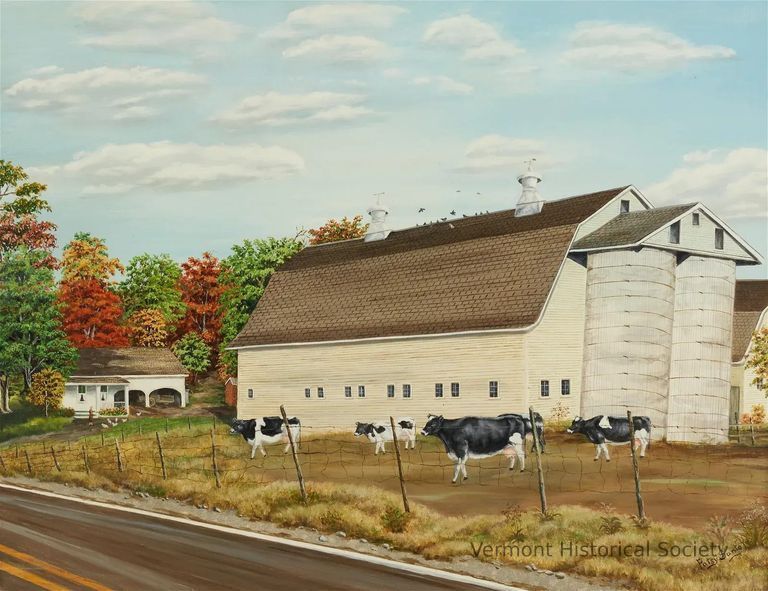
Farm Route 67 with Cows, Autumn
Name/Title
Farm Route 67 with Cows, Autumn
Type of Painting
Lexicon
Description
Oil painting of a farm on Vermont Route 67 with cows in autumn by Patsy Santo. The painting features a paved road with a double yellow center line in the closest foreground and a slightly golden-tinged fenced-in pasture with black and white cattle just behind it. The pale yellow barn has a brown shingle roof and white silos on the near side, and a white farmhouse peeks out of the fall-tinged trees on the left middle ground. The blue sky above has scattered puffy clouds. The painting is signed "Patsy Santo in the lower right corner and resides in a painted and gilt wooden frame.
Acquisition
Accession
2024.10
Relationships
Related Person or Organization
Santo, Pasquale "Patsy" (1893-1975)
Person or Organization
Artwork Details
Medium
Oil on Canvas
Subject
Dairy farm; Route 67
Made/Created
Artist Information
Santo, Pasquale "Patsy" (1893-1975)
Artist
Date made
1960-1970
Dimensions
Entry/Object ID
2024.10.1
Context
Patsy Santo pursued a number of professional activities after emigrating to this country from Italy in 1913. He worked for the railroad and as a housepainter. His first artistic effort was an outgrowth of one of his house painting jobs; his second was undertaken at the request of a friend. He did not follow up on these sporadic endeavors until many years later, however, when one of his paintings took first prize at the 1937 state fair in Rutland, Vermont. This brought Santo his first patron and inspired him to start painting in earnest. Other exhibitions followed. His introduction to the New York art world was about as auspicious as any folk painter could hope for. He debuted, with Grandma Moses, Morris Hirshfield, and a number of others, in a 1939 members-only showing at the Museum of Modern Art. His first one-man show at the Marie Harriman Gallery the following year was a virtual sell-out. His paintings were acquired by the Whitney Museum and the Museum of Modern Art. Sidney Janis included him in his book, "They Taught Themselves," observing that Santo, unlike most self-taught painters, evidenced continuing stylistic development.


Henry Bridge
Name/Title
Henry Bridge
Type of Painting
Description
A framed painting of a landscape with a red covered bridge spanning a flowing river, flanked by lush green trees on either side, while a grassy riverbank stretches into the foreground. A low dam with flowing water can be seen under the bridge. A man stands with a horse at the river's edge.
Painting is identified as the Henry Covered Bridge in North Bennington by Pasquale Santo. Signed "Patsy Santo" in yellow lower right.
Painting is identified as the Henry Covered Bridge in North Bennington by Pasquale Santo. Signed "Patsy Santo" in yellow lower right.
Acquisition
Accession
2024.25
Artwork Details
Medium
Oil
Subject
Henry Covered Bridge
Made/Created
Artist Information
Santo, Pasquale "Patsy" (1893-1975)
Artist
Date made
1946
Entry/Object ID
2024.25.1
Context
Patsy Santo pursued a number of professional activities after emigrating to this country from Italy in 1913. He worked for the railroad and as a housepainter. His first artistic effort was an outgrowth of one of his house painting jobs; his second was undertaken at the request of a friend. He did not follow up on these sporadic endeavors until many years later, however, when one of his paintings took first prize at the 1937 state fair in Rutland, Vermont. This brought Santo his first patron and inspired him to start painting in earnest. Other exhibitions followed. His introduction to the New York art world was about as auspicious as any folk painter could hope for. He debuted, with Grandma Moses, Morris Hirshfield, and a number of others, in a 1939 members-only showing at the Museum of Modern Art. His first one-man show at the Marie Harriman Gallery the following year was a virtual sell-out. His paintings were acquired by the Whitney Museum and the Museum of Modern Art. Sidney Janis included him in his book, "They Taught Themselves," observing that Santo, unlike most self-taught painters, evidenced continuing stylistic development.
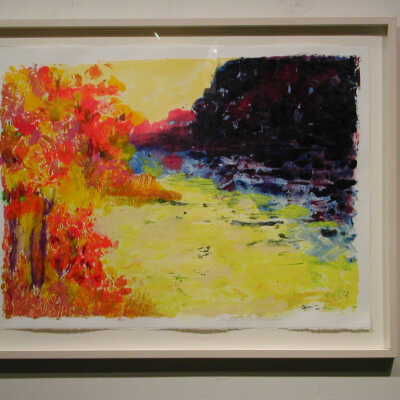
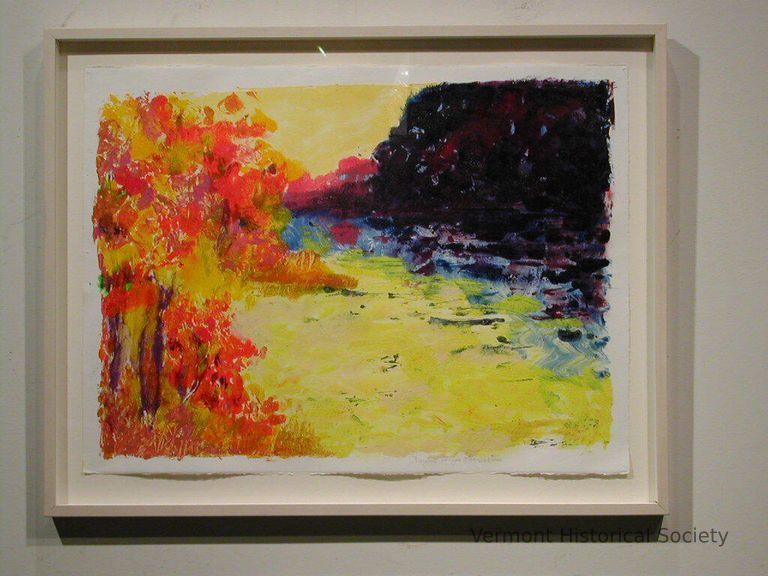
Late Afternoon on the River, October
Interpretative Labels
Label
Kannenstine graduated from the Washing University School of Fine Art in St. Louis and studied at the Arts Student's League in New York. She lives in Woodstock, Vermont and has exhibited throughout the Northeast.
Name/Title
Late Afternoon on the River, October
Lexicon
Description
"Late Afternoon on the River, October"
monotype on paper (monotypes= Unique prints made by using the process of monotype and a printing process that consists of painting an image onto a plate and then printing it.)
monotype on paper (monotypes= Unique prints made by using the process of monotype and a printing process that consists of painting an image onto a plate and then printing it.)
Acquisition
Accession
2000.2
Relationships
Related Places
Place
Woodstock
Town
Windsor County
County
Vermont
State/Province
United States of America
Country
North America
Artwork Details
Medium
Acrylic
Made/Created
Artist Information
Kannenstine, Margaret Lampe (1938-2023)
Artist
Dimensions
Entry/Object ID
2000.2.1
Context
Born in St. Louis, Missouri, Peggy Lampe attended Washington University in St Louis where she earned a Bachelor of Fine Arts?degree in 1959. While there she met Louis Fabian Kannenstine, who later became her husband. In 1959 Peggy began pursuing post-graduate studies through the Art Students’ League in New York City.
In the early 1960’s her family began spending summers in East Barnard, Vermont, eventually buying a summer home there in 1966. Time in Vermont brought Peg great joy. When, after being diagnosed with multiple sclerosis in the mid 1970’s, it became apparent that she was healthier during their stays there, the family relocated to Vermont, this time to Woodstock, where they finally settled in the mid-1980s.
From the mid-1970s onward, Peg exhibited her work in a plethora of one-woman, juried and group shows, primarily throughout New England. Her work continues to be featured by various galleries along the eastern seaboard. Peg also co-authored “From Luminous Shade” along with Ann? McGarrell.
In the early 1960’s her family began spending summers in East Barnard, Vermont, eventually buying a summer home there in 1966. Time in Vermont brought Peg great joy. When, after being diagnosed with multiple sclerosis in the mid 1970’s, it became apparent that she was healthier during their stays there, the family relocated to Vermont, this time to Woodstock, where they finally settled in the mid-1980s.
From the mid-1970s onward, Peg exhibited her work in a plethora of one-woman, juried and group shows, primarily throughout New England. Her work continues to be featured by various galleries along the eastern seaboard. Peg also co-authored “From Luminous Shade” along with Ann? McGarrell.
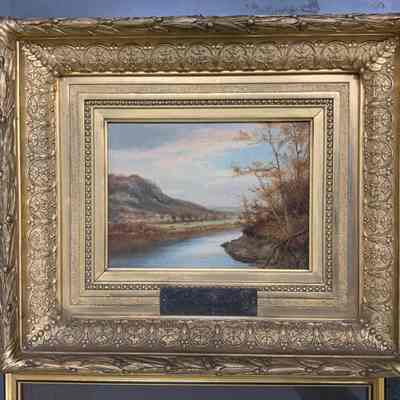
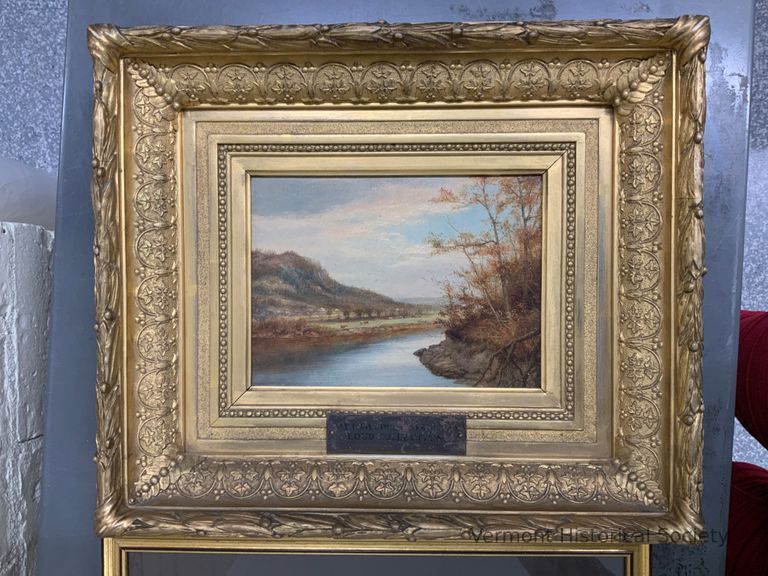
Mount Tom
Name/Title
Mount Tom
Type of Painting
Lexicon
Description
Oil on canvas painting of Mount Tom by Charles Franklin Pierce. The painting features a blue sky with wisps of darkened clouds that lighten as they pass over the peak towards the river. The landscape shows a fall scene, with scattered orange and brown leaves on the trees and a pale green field on the far bank of the river. The painting is set into a carved gilt gesso frame.
Acquisition
Accession
2024.6
Relationships
Related Person or Organization
Pierce, Charles Franklin (1844-1920)
Person or Organization
Artwork Details
Medium
Oil on Canvas
Subject
Mount Tom
Made/Created
Artist Information
Charles Franklin Pierce
Artist
Dimensions
Entry/Object ID
2024.6.3
Context
Charles Franklin Pierce was born on April 26th, 1844 in Sharon, New Hampshire to John A. and Phila W. Pierce. He was the third of six children who were raised in the nearby rural community of Peterborough. His early years were spent working on the family farm where the pastoral environment and a multitude of livestock made a deep impression on the future artist. Many of the works of art he would create later on in his life would stem from his familiarity with the farming way of life in the mid 1800s. Cows were one of his favorite subjects.
In the early 1860s his creative energies started to emerge and the drudgery of farm work was certainly no outlet for them, so in 1864 he decided to move to Boston to attend art school. Over the next few years he developed his skills at school and in the latter 1860s took his sketchbooks and went to England, Scotland and Wales to sketch the countryside there. This was his first of two prolonged stays in Europe during his lifetime and he honed his craft through his acute attention to detail.
The Early 1870s found Pierce back in Boston where he was a leader in the Boston Art Club and as the country celebrated the centennial of its founding, Pierce married his first wife Luena Wilder of Peterborough who was also an artist of note. They both returned to Europe in the late 1870s and sketched and painted and toured for over a year. They continued to paint both European and New England scenes in a Boston studio and at an estate in Peterborough and after 30 years of marriage Luena died in 1906.
Pierce continued to paint and draw and in 1912, he married Sarah Katherine Plimpton of Massachusetts. They lived on his estate in Peterborough and in Brookline Massachusetts where he died in 1920 on March 5th. In his studio upon his death were found numerous unfinished canvases, which attest to his liveliness right up to his final breath at the age of 67.
In the early 1860s his creative energies started to emerge and the drudgery of farm work was certainly no outlet for them, so in 1864 he decided to move to Boston to attend art school. Over the next few years he developed his skills at school and in the latter 1860s took his sketchbooks and went to England, Scotland and Wales to sketch the countryside there. This was his first of two prolonged stays in Europe during his lifetime and he honed his craft through his acute attention to detail.
The Early 1870s found Pierce back in Boston where he was a leader in the Boston Art Club and as the country celebrated the centennial of its founding, Pierce married his first wife Luena Wilder of Peterborough who was also an artist of note. They both returned to Europe in the late 1870s and sketched and painted and toured for over a year. They continued to paint both European and New England scenes in a Boston studio and at an estate in Peterborough and after 30 years of marriage Luena died in 1906.
Pierce continued to paint and draw and in 1912, he married Sarah Katherine Plimpton of Massachusetts. They lived on his estate in Peterborough and in Brookline Massachusetts where he died in 1920 on March 5th. In his studio upon his death were found numerous unfinished canvases, which attest to his liveliness right up to his final breath at the age of 67.
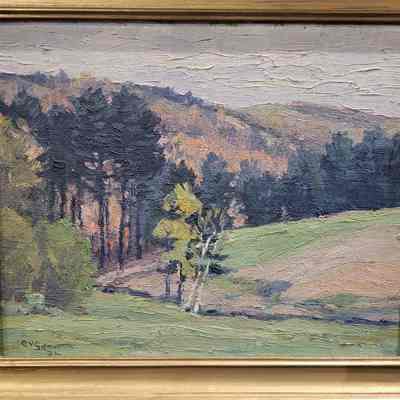
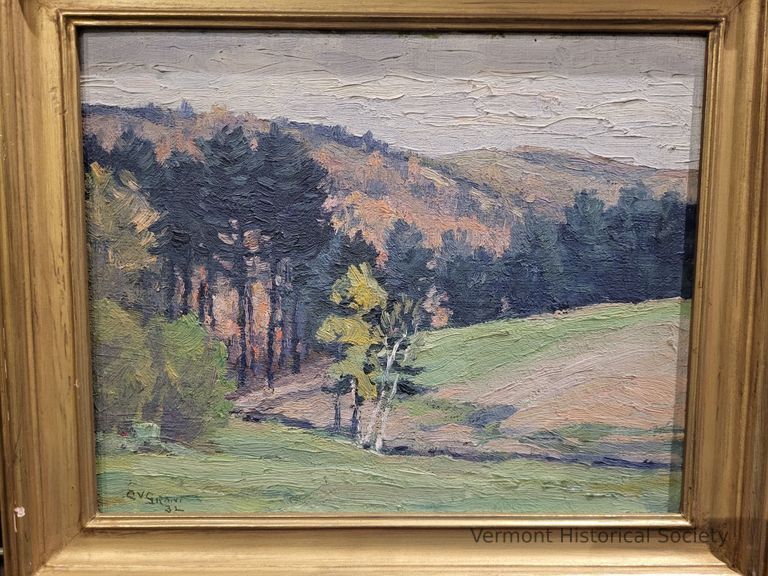
Mountain View
Name/Title
Mountain View
Type of Painting
Lexicon
Description
Oil painting showing green rolling hills in front of a forest of tall trees and hills dotted with autumn colors. The lower corner is signed, "CV GRANT 32".
Acquisition
Accession
1957.1
Artwork Details
Medium
Oil
Made/Created
Artist Information
Grant, Cecil Vezin (1880-1953)
Artist
Date made
1932
Dimensions
Entry/Object ID
1957.1.343
Context
Cecil V. Grant was born in Jersey City, New Jersey on July 20, 1880. He was educated at the Pingry School in Elizabeth, NJ, and after his marriage to Mary Jack they relocated to Elizabeth where their only child, Lois, was born in 1914.
Grant was a stockbroker, commuting to Wall Street in New York City each day. On weekends he was a “Hobby Painter,” and traveled to the New Jersey shore, Gloucester, Massachusetts, and in the 1920s to southern Vermont. In the late 1920s he purchased an old farmhouse between Londonderry and Peru on Rt. 11.
The farmhouse was intended to be a summer vacation home, but the Wall Street Crash of October 1929 changed all that: Cecil Grant lost his job, his life savings and even his home in Elizabeth, NJ. He moved his family to the Vermont farmhouse, struggled to make ends meet with odd jobs, and continued his painting just to keep occupied. But in the depths of the Great Depression, Grant began to win prizes for some of his paintings exhibited locally. From then until his death in March 1953 he painted over a thousand oil landscapes of Vermont, virtually all of scenes within a 30 mile radius of his Londonderry home. He painted year around, and in the summers he had what amounted to a one man show on the village green in Manchester, next to Walter Hard’s drugstore and across the street from the Equinox House hotel. In his later years he also operated The Manchester Art Gallery in what is now the Brewster Funeral Home in Manchester Center.
Grant was a stockbroker, commuting to Wall Street in New York City each day. On weekends he was a “Hobby Painter,” and traveled to the New Jersey shore, Gloucester, Massachusetts, and in the 1920s to southern Vermont. In the late 1920s he purchased an old farmhouse between Londonderry and Peru on Rt. 11.
The farmhouse was intended to be a summer vacation home, but the Wall Street Crash of October 1929 changed all that: Cecil Grant lost his job, his life savings and even his home in Elizabeth, NJ. He moved his family to the Vermont farmhouse, struggled to make ends meet with odd jobs, and continued his painting just to keep occupied. But in the depths of the Great Depression, Grant began to win prizes for some of his paintings exhibited locally. From then until his death in March 1953 he painted over a thousand oil landscapes of Vermont, virtually all of scenes within a 30 mile radius of his Londonderry home. He painted year around, and in the summers he had what amounted to a one man show on the village green in Manchester, next to Walter Hard’s drugstore and across the street from the Equinox House hotel. In his later years he also operated The Manchester Art Gallery in what is now the Brewster Funeral Home in Manchester Center.
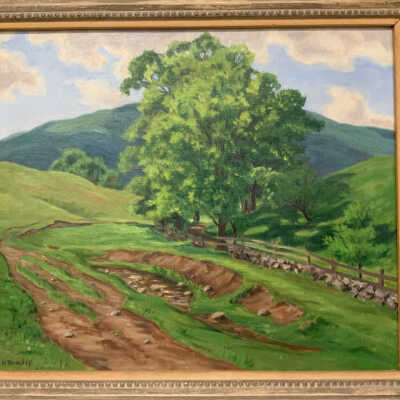

Muddy Lane
Name/Title
Muddy Lane
Type of Painting
Lexicon
Description
Oil on canvas painting showing a grassy and muddy landscape, with various trees and small rocks throughout. On the right side of the painting, post and rail fencing stands above a rock wall, separating a muddy depression on the left, and a grassy hill with many trees on the right.
In the background, a dark green mountain spreads to both sides of the canvas, illuminated by a blue sky, adorned with clouds of various shapes and sizes. It is signed in black ink at the bottom left, "L H Towsley".
In the background, a dark green mountain spreads to both sides of the canvas, illuminated by a blue sky, adorned with clouds of various shapes and sizes. It is signed in black ink at the bottom left, "L H Towsley".
Acquisition
Accession
2022.26
Relationships
Related Places
Place
Manchester
Town
Bennington County
County
Vermont
State/Province
United States of America
Country
North America
Artwork Details
Medium
Oil
Made/Created
Artist Information
Towsley, Leale Hastings (1888-1963)
Artist
Date made
1930-1945
Dimensions
Dimension Description
Overall
Entry/Object ID
2022.26.1
Context
Leale Towsley was born and raised in Manchester, Vermont. He attended Burr and Burton Seminary and worked in Manchester until enlisting in the Army for WWI. Upon discharge he returned to Manchester, but soon left for California to study art.
He visited Manchester frequently and was a member of Southern Vermont Artists. He returned to Vermont permanently in 1950 when he took residence at the Vermont Soldier's Home in Bennington.
He visited Manchester frequently and was a member of Southern Vermont Artists. He returned to Vermont permanently in 1950 when he took residence at the Vermont Soldier's Home in Bennington.
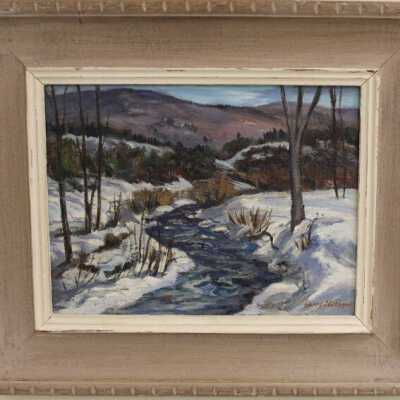
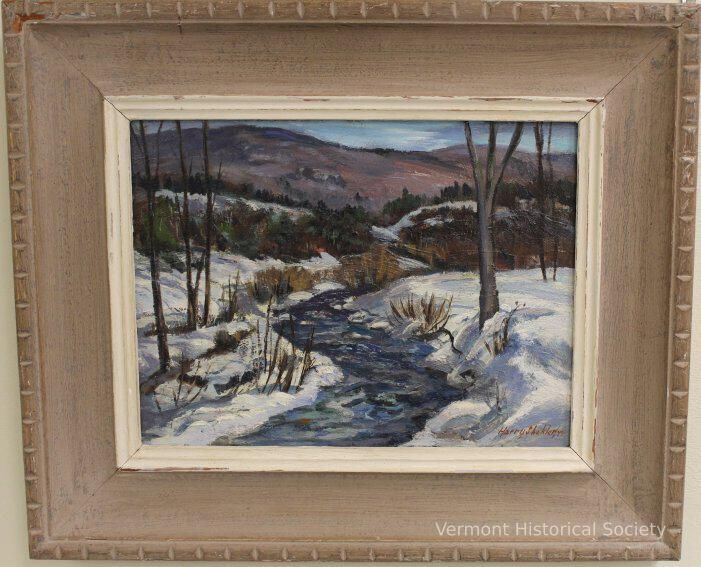
Painting
Name/Title
Painting
Lexicon
Description
Landscape probably West River in Weston, VT. Signed Harry Shokler, 1949.
Beige wooden outer frame with white inner frame. Shows a landscape with hills in the background and a river in the center of the oil painting flowing towards the bottom of the frame, a winter scene. Bare trees and shrubs line the banks. Hues are in blues, browns, whites, with some green and beige pinks. Signed in red paint.
Beige wooden outer frame with white inner frame. Shows a landscape with hills in the background and a river in the center of the oil painting flowing towards the bottom of the frame, a winter scene. Bare trees and shrubs line the banks. Hues are in blues, browns, whites, with some green and beige pinks. Signed in red paint.
Acquisition
Accession
2019.4
Made/Created
Artist Information
Shokler, Harry (1896-1978)
Artist
Date made
1949
Dimensions
Materials
Material
Masonite
Entry/Object ID
2019.4.1
Context
Born in Cincinnati, Shokler's early training took place at the city's academy of fine arts. He later studied in New York and Philadelphia. He was originally based in New York, with a teaching specialization in print-making. After a stint in the Works Progress Administration's Federal Art Project, he discovered a love for Southern Vermont. In 1934, he and his wife rented a summer cottage in South Londonderry and became involved in the Southern Vermont Artists group in Manchester.
By the early 1940s they had purchased an old farmhouse and renovated a barn into a studio and gathering place. They ended up becoming year-round residents of Vermont, painting and printing its impressive landscape. Shokler's work was widely exhibited during his lifetime and many museum feature his paintings and prints in their collections.
By the early 1940s they had purchased an old farmhouse and renovated a barn into a studio and gathering place. They ended up becoming year-round residents of Vermont, painting and printing its impressive landscape. Shokler's work was widely exhibited during his lifetime and many museum feature his paintings and prints in their collections.
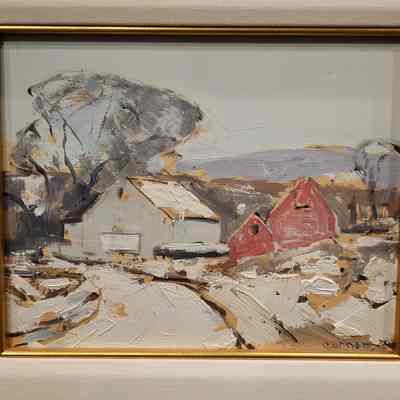

Road to Sunderland
Name/Title
Road to Sunderland
Lexicon
Description
Small oil painting of a winter farm scene. A road in the foreground leads to a grey barn with other red outbuildings. A large tree appears behind the barn and mountains can be seen in the background. The painting is mostly in shades of greys and browns except for the two red buildings. A label affixed to the back entitles the painting, "Road to Sunderland."
Acquisition
Accession
2017.12
Artwork Details
Made/Created
Artist Information
Connaway, Jay Hall (1893-1970)
Artist
Date made
1955-1969
Entry/Object ID
2017.12.2
Context
Jay Connaway was born in Liberty, Indiana, November 27, 1893, the son of Cass Connaway, a lawyer and collector of Chinese art, and his wife May. Jay Connaway graduated from Emmerich Manual High School and undertook his first art training from William Forsyth, known for coastal Oregon views, at John Herron School of Art in Indianapolis in 1910 and 1911. Connaway left home to tour the California and Oregon coasts, working his way across the country and then back to the East Coast as a stoker on engines for the Atchison, Topeka, and Santa Fe Railroad.
In New York, Connaway enrolled at the National Academy of Design school in 1912. From 1912 to 1914 he attended the Art Student's League at New York City, where he studied with George Bridgman and with William Merritt Chase. Another influence was Robert Henri, a New York Social Realist and leader of the Ashcan School, whom Connaway had met while attending night classes at the National Academy.
In 1917 he enlisted and shipped out to Contrexeville, France. After suffering a shoulder wound, he worked as a cartographer. Then he was assigned to what he called "the most wonderful work of my life"—making detailed watercolor drawings of lesions caused by mustard gas. This brought him to the attention of Lafayette Page, a physician who was so impressed with Connaway's draftsmanship that, at the close of the war, he sponsored his studies at the Académie Julian (1919–20) under Jean Paul Laurens and at the École des Beaux-Arts (1921) in Paris.
With backing from collectors and gallery owners, Connaway, "seeking to paint the lonely sea" found his way to uninhabited Head Harbor Island off the coast of Jonesport, Maine where he lived as an artistic hermit. He later worked dories with a Grand Banks fishing fleet, was also a cook for a lumber camp in Maine, and he enlisted in the Coast Guard.
In 1928 Connaway married Louise Boehle. During the depression, Connaway moved to Monhegan Island to paint and start the Connaway Art School.
The Connaways remained on Monhegan until 1947, when they moved to Vermont, residing in Dorset until 1953, then North Rupert. Connaway painted rural landscapes of the Vermont countryside and operated a summer art school, until 1966.
In 1962, Connaway merged his school with the Southern Vermont Arts Center and became the school's first director. During the 1960s, in addition to managing the art school Connaway painted in Portugal, Spain, California, and Arizona. In the last year of his life, troubled with poor eyesight and failing health, Connaway was no longer able to paint.
In New York, Connaway enrolled at the National Academy of Design school in 1912. From 1912 to 1914 he attended the Art Student's League at New York City, where he studied with George Bridgman and with William Merritt Chase. Another influence was Robert Henri, a New York Social Realist and leader of the Ashcan School, whom Connaway had met while attending night classes at the National Academy.
In 1917 he enlisted and shipped out to Contrexeville, France. After suffering a shoulder wound, he worked as a cartographer. Then he was assigned to what he called "the most wonderful work of my life"—making detailed watercolor drawings of lesions caused by mustard gas. This brought him to the attention of Lafayette Page, a physician who was so impressed with Connaway's draftsmanship that, at the close of the war, he sponsored his studies at the Académie Julian (1919–20) under Jean Paul Laurens and at the École des Beaux-Arts (1921) in Paris.
With backing from collectors and gallery owners, Connaway, "seeking to paint the lonely sea" found his way to uninhabited Head Harbor Island off the coast of Jonesport, Maine where he lived as an artistic hermit. He later worked dories with a Grand Banks fishing fleet, was also a cook for a lumber camp in Maine, and he enlisted in the Coast Guard.
In 1928 Connaway married Louise Boehle. During the depression, Connaway moved to Monhegan Island to paint and start the Connaway Art School.
The Connaways remained on Monhegan until 1947, when they moved to Vermont, residing in Dorset until 1953, then North Rupert. Connaway painted rural landscapes of the Vermont countryside and operated a summer art school, until 1966.
In 1962, Connaway merged his school with the Southern Vermont Arts Center and became the school's first director. During the 1960s, in addition to managing the art school Connaway painted in Portugal, Spain, California, and Arizona. In the last year of his life, troubled with poor eyesight and failing health, Connaway was no longer able to paint.
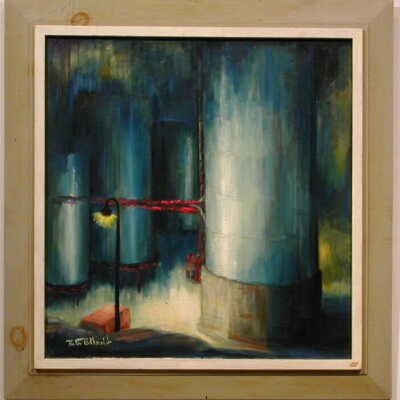
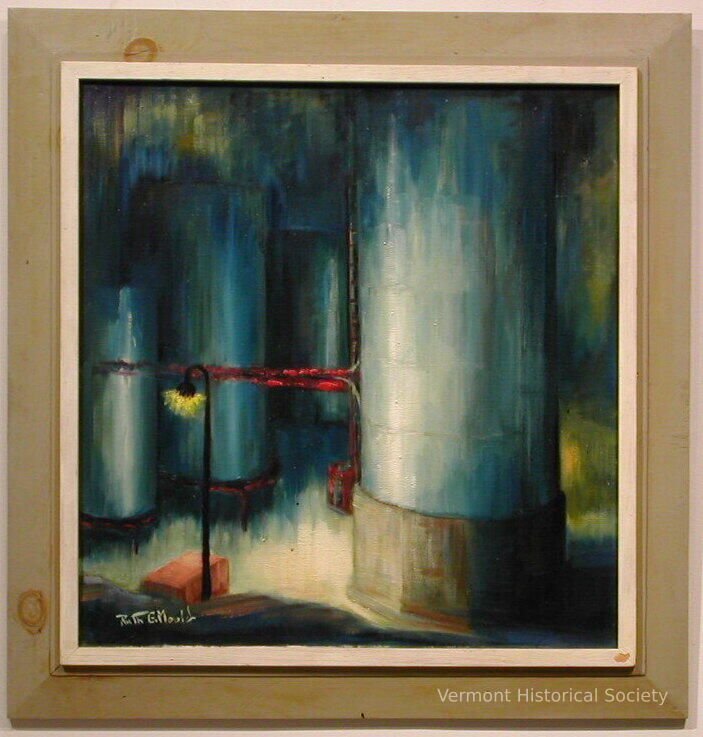
Storage Silos in Monkton
Name/Title
Storage Silos in Monkton
Type of Painting
Lexicon
Description
Oil on canvas painting depicting several metal-clad tubes (silos) painted in shades of blue with red piping. A black streetlight illuminates the bottom-left corner. The artist's signature appears below the streetlight.
Acquisition
Accession
1998.22
Artwork Details
Medium
Oil
Subject
Silos
Made/Created
Artist Information
Mould, Ruth Greene (1894-1979)
Artist
Date made
1961
Dimensions
Dimension Description
Overall
Entry/Object ID
1998.22.26
Context
Vermont portrait artist Ruth G. Mould was born in Morrisville, Vermont on May 22, 1894. She was a graduate of local schools, Peoples Academy and Johnson Normal School, which prepared her for an early career as a teacher in the Cadys Falls district school house, teaching Grades 1 - 8. The visual arts, however, commanded her interest as a young woman, and an uncle sponsored her further studies at the Institute of Art in St. Paul, Minnesota, from which she graduated with honors. From there, she went on to study at the Art Students League in New York City, before she married Willis Mould in 1919, and returned to Vermont.
Throughout her married life and beyond, whether she was teaching art students at Johnson Normal School, tutoring private art students, and while she was raising her son, Channing, Ruth Mould's husband made sure she had her own private art studio wherever his work as a mining engineer took his family. They lived in Vermont in Morristown, Monkton, Johnson, Williamstown and Barre, and in New York State in Keysville.
Mould was one of two artists whose work represented the State of Vermont at the 1939 World's Fair in New York. However, she was best known for her portraits, including a posthumous portrait of Edna Beard, first female member of both the Vermont House and Senate, which hangs in the State House, and portraits of three Vermont Chief Justices in the Vermont Supreme Court Building.
A selection of Mould's work is permanently installed in the lobby at the Dibden Center for the Arts at Johnson State College, and other works are represented in the permanent collections of the Fleming Museum, The Vermont Historical Society, and the Bennington Museum. The Bryan Memorial Gallery in Jeffersonville represents Mould's estate with works for sale.
In addition to some book illustration, Mould also wrote a book on Refinishing and Decorating Furniture (1953.) She was a member of the Northern Vermont Artist Association and an honorary lifetime member of the Art Students League in New York.
Ruth Mould died on February 13, 1979.
Throughout her married life and beyond, whether she was teaching art students at Johnson Normal School, tutoring private art students, and while she was raising her son, Channing, Ruth Mould's husband made sure she had her own private art studio wherever his work as a mining engineer took his family. They lived in Vermont in Morristown, Monkton, Johnson, Williamstown and Barre, and in New York State in Keysville.
Mould was one of two artists whose work represented the State of Vermont at the 1939 World's Fair in New York. However, she was best known for her portraits, including a posthumous portrait of Edna Beard, first female member of both the Vermont House and Senate, which hangs in the State House, and portraits of three Vermont Chief Justices in the Vermont Supreme Court Building.
A selection of Mould's work is permanently installed in the lobby at the Dibden Center for the Arts at Johnson State College, and other works are represented in the permanent collections of the Fleming Museum, The Vermont Historical Society, and the Bennington Museum. The Bryan Memorial Gallery in Jeffersonville represents Mould's estate with works for sale.
In addition to some book illustration, Mould also wrote a book on Refinishing and Decorating Furniture (1953.) She was a member of the Northern Vermont Artist Association and an honorary lifetime member of the Art Students League in New York.
Ruth Mould died on February 13, 1979.
Web Links and URLs
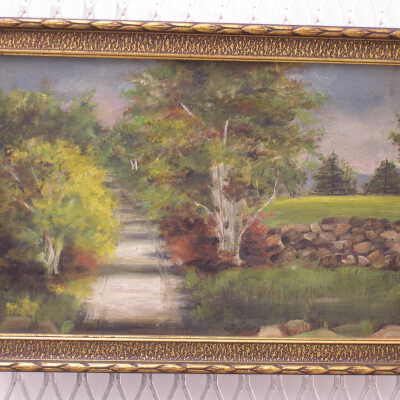
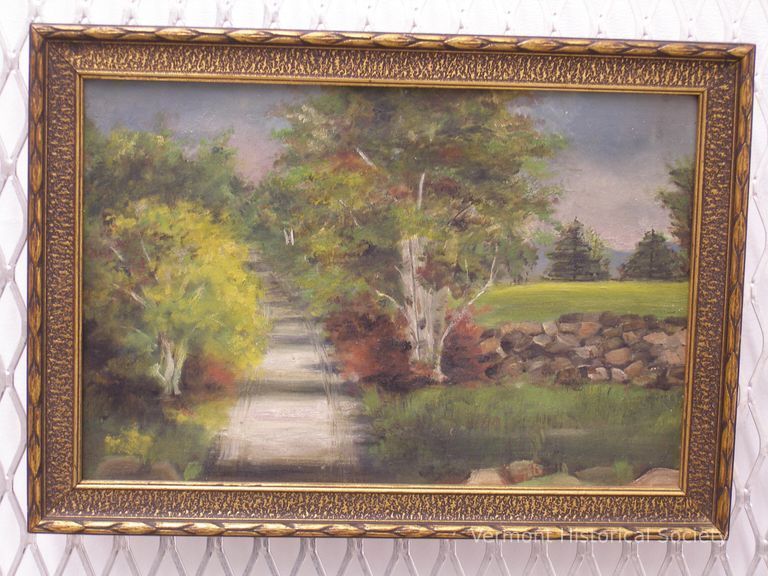
Untitled Landscape
Name/Title
Untitled Landscape
Lexicon
Description
Oil on canvas of a country road, framed by birch trees with green leaves and stone wall, probably East Ryegate. Back is signed Mrs. J. F. Devins.
Acquisition
Accession
2007.63
Artwork Details
Medium
Oil on Canvas
Made/Created
Artist Information
Devins, Laura
Artist
Date made
circa 1930
Dimensions
Entry/Object ID
2007.63.2
Context
Laura Devins lived in East Ryegate with her husband Joseph Devins, a foreman at the local paper mill. Painting was probably a hobby, as her work is not found on the market or in collecting institutions.

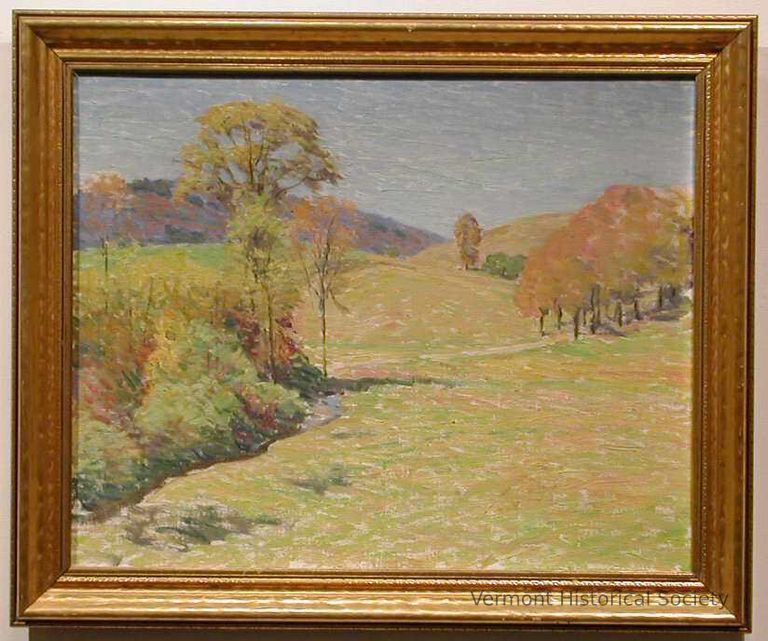
Vermont Scene
Name/Title
Vermont Scene
Type of Painting
Lexicon
Description
Landscape painting depicting a meadow in the foreground with a clump of trees and shrubbery by a brook on the left. There is a road leading across the center horizontally to another group of trees covered in fall foliage.
Acquisition
Accession
1958.1
Relationships
Related Person or Organization
Brown, Horace (1876-1949)
Person or Organization
Artwork Details
Medium
Oil
Made/Created
Artist Information
Brown, Horace (1876-1949)
Artist
Date made
1930
Dimensions
Entry/Object ID
1958.1.1570
Context
Horace Brown was born in Chicago, 1876, and died in New York City on Good Friday, 1949. He graduated from Yale with the class of 1900. After a brief unhappy period as an officer in the family business, he devoted himself to the study of art and landscape painting around the year 1906, winning occasional prizes and exhibiting widely in the East. His paintings form part of the permanent collections of the Springfield (MA) Art Museum and the Pennsylvania Academy of Fine Arts in Philadelphia. In 1914 he married Caroline H. Clement, daughter of former Vermont Governor, Percival H. Clement, and made "North Mowing" in Springfield, Vermont, his residence. This property had been built by his great grandfather in 1790, and has remained in the family since that time. He was one of the founders of the Southern Vermont Artists Association in Manchester, Vermont, and served on numerous local committees in Springfield. His interest in restricting billboards caused him to enter politics with the view of interesting the state legislature to pass restrictive laws against this menace. He served in the 1939 Assembly, representing the town of Springfield. His wife predeceased him in 1945. They had no children.

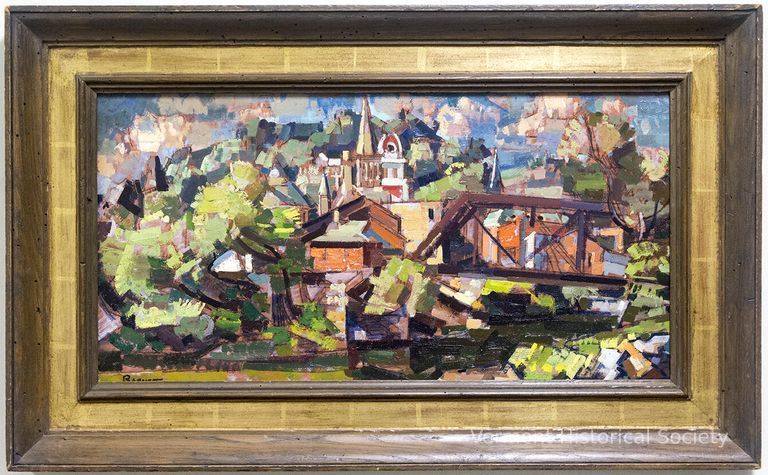
View of Montpelier
Interpretative Labels
Name/Title
View of Montpelier
Type of Painting
Lexicon
Description
Oil-on-masonite landscape painting showing Montpelier, Vermont from across the river. The painting is done in thick, heavy strokes. There is a metal bridge on the right side, and church steeple in the center.
Acquisition
Accession
1989.45
Artwork Details
Medium
Oil
Made/Created
Artist Information
Barnett, Herbert Phillip (1910-1972)
Artist
Date made
circa 1940
Dimensions
Entry/Object ID
1989.45.1
Context
The bulk of Herbert Barnett's work represents his life in New England. His distinctive style of painting draws upon both an American tradition of representation as well as the innovation of the Cubists.
Born in Cranston, Rhode Island, Barnett grew up in Providence. While still in high school, he began to study painting at the Rhode Island School of Design. From 1927-31, he studied at the Boston Museum School and soon acquired a reputation for technical proficiency. After art school, Barnett spent three years traveling and studying in Europe. From the time of his return to the United States in 1934 until 1940, he divided his time between Cape Ann, Mass. and New York City.
In 1940, he became the head of the Worcester Museum School and began summering in Vermont, where he produced a distinctive group of landscapes of quarries, farms, bridges and mills. In 1951, Barnett became dean of the Art Academy of Cincinnati, the school of the Cincinnati Art Museum. Until his death in 1972, he remained at the Art Academy of Cincinnati, returning to central Massachusetts each summer to paint.
Born in Cranston, Rhode Island, Barnett grew up in Providence. While still in high school, he began to study painting at the Rhode Island School of Design. From 1927-31, he studied at the Boston Museum School and soon acquired a reputation for technical proficiency. After art school, Barnett spent three years traveling and studying in Europe. From the time of his return to the United States in 1934 until 1940, he divided his time between Cape Ann, Mass. and New York City.
In 1940, he became the head of the Worcester Museum School and began summering in Vermont, where he produced a distinctive group of landscapes of quarries, farms, bridges and mills. In 1951, Barnett became dean of the Art Academy of Cincinnati, the school of the Cincinnati Art Museum. Until his death in 1972, he remained at the Art Academy of Cincinnati, returning to central Massachusetts each summer to paint.
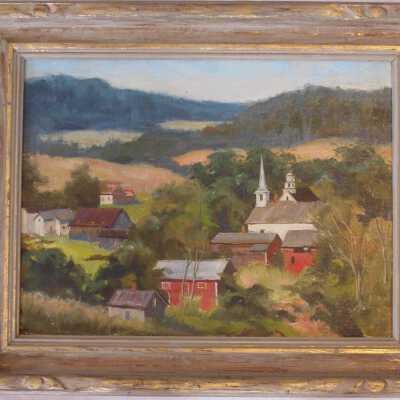
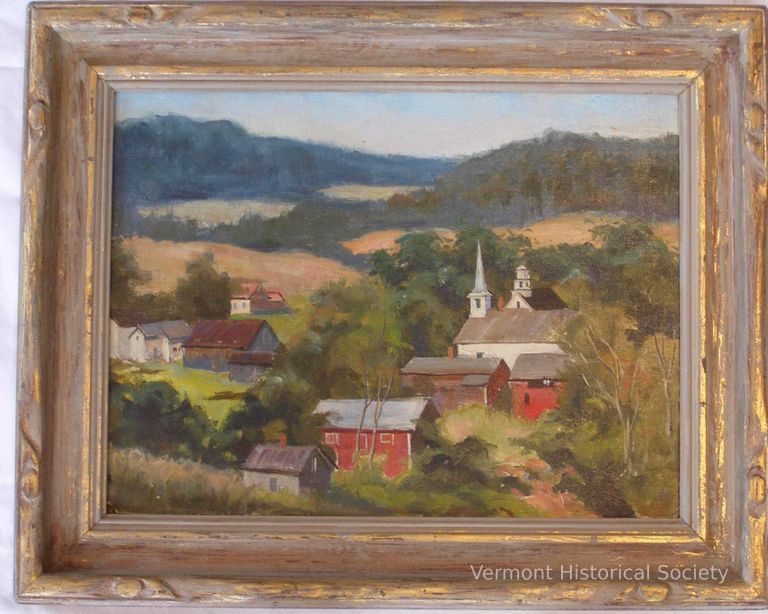
Waterville, Vermont
Name/Title
Waterville, Vermont
Type of Painting
Lexicon
Description
Landscape painting showing a town nestled amid rolling hills and mountains. The town consists of a white church with pointed steeple, a white municipal building with a cupola behind, and several red and white building before. The hills in the foreground are green with tall, thin trees. The hills in the middle ground are golden, indicating agricultural use, and the hills/mountains in the background are dark.
Acquisition
Accession
2009.28
Artwork Details
Medium
Oil, Wood
Made/Created
Artist Information
Barrett, Robert
Artist
Dimensions
Entry/Object ID
2009.28.2
Context
A card tacked to the back of the frame indicates this image is entitled "Waterville" and painted by Robert Barrett.
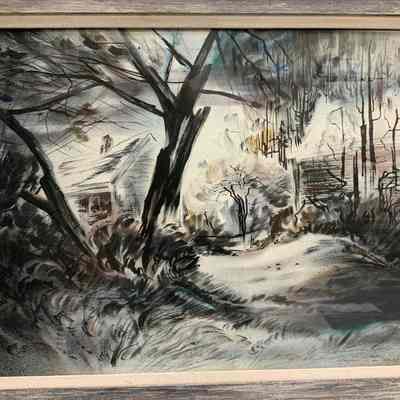

Winter
Name/Title
Winter
Type of Painting
Description
Mostly black and white watercolor on paper depicting a small house in the background, viewed through two trees in the foreground. Titled by the artist in lower right, "Winter."
Acquisition
Accession
2023.10
Artwork Details
Medium
Watercolor
Made/Created
Artist Information
Healy, Arthur Kelly David (1902-1978)
Artist
Entry/Object ID
2023.10.1
Context
Artist Arthur Healy had an outsized impact on Middlebury College where he was artist-in-residence and the Sheldon Museum where he worked tirelessly to expand the archives and help shepherd the creation of the Stewart-Swift research center.